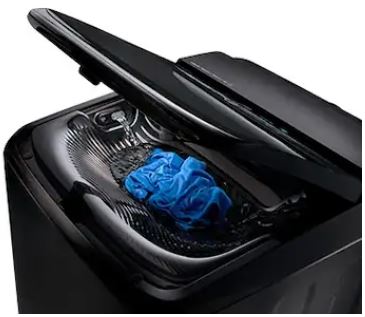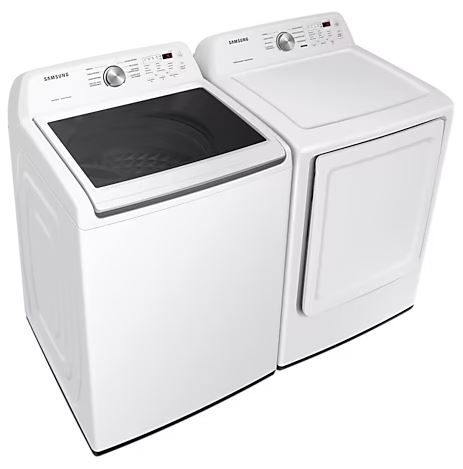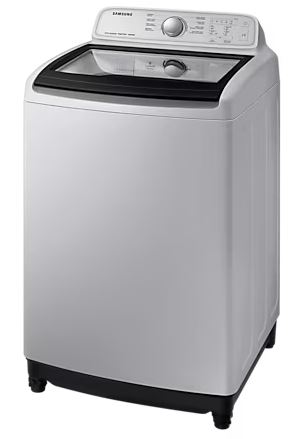The last thing you expect from your washing machine is for it to fail to start. However, that can happen to a Samsung top-loader, and if you have one, you probably are wondering why your Samsung top-load washer won’t start cycle.
In most cases, a Samsung top-load washer won’t start a cycle due to a wrong setting, a nonresponsive control panel, power or water interruption, poor loading, an unlatched lid, drain hose blockage, or a component fault.
The component that could be faulty in this case is either the timer, motor, start capacitor, or control board, and in all cases, a replacement may be necessary, and more often than not, you need an expert’s help.
I’ll help you understand how those eight issues stop your top loader from starting and how well you can troubleshoot it. Moreover, we’ll look at a few similar problems you may encounter if you have a Samsung top loader and how to address them.
Let’s dive in!

In a hurry? Below are eight quick fixes to the eight issues that usually stop Samsung washers from starting a wash cycle.
Samsung Top Load Washer Won’t Start Wash Cycle – Quick Fixes
| – | Probable Cause | Quick Fix |
| 1. | Wrong Setting | Cancel Delay Start and restart the washer. |
| 2. | Nonresponsive Control Panel | Deactivate the Child Lock, reset the washer, free up any stuck button, and replace the control panel in case of a damaged button. |
| 3. | Power Interruption | Check for a tripped breaker, faulty socket, or damaged/loose power cord and fix them accordingly. |
| 4. | Water Interruption | Ensure the water supply valves are open, the supply hoses are not kinked or leaky, and the water pressure is sufficient (at least 20 psi) |
| 5. | Poor Loading | Evenly spread the laundry in the drum, and don’t overload it. |
| 6. | Unlatched Lid | Properly latch the lid, remove any obstruction, and if the lid switch is defective, replace it. |
| 7. | Drain Hose Blockage | Unclog the drain hoses. |
| 8. | Component Fault | Replace a faulty timer, motor, start capacitor, or control board. |
Why a Samsung Top-Load Washer Won’t Start Cycle
A Samsung top-load washing machine won’t start a cycle for different reasons, and below are the most typical 8:
1. Wrong Setting
Sometimes, the wrong setting is all it takes to stop a washer from running. So, check if you’ve selected an incorrect wash setting. For example, setting the washer on Delay Start won’t start until the preset time.
Delay Start usually delays the washer’s start time by 1-24 hours, thus perfect when you want to do laundry at a particular time but do not want to forget.
Fix
If the washer is on Delay Start, cancel the setting. Then restart the washer and choose the correct cycle setting.
2. Nonresponsive Control Panel
Your Samsung washing machine will not start if the control panel is nonresponsive. Remember, the control panel receives commands and relays them to the relevant washer components. So, if it’s unable to pick up those signals, it’s inept to relay anything, and the washer will, therefore, not run.
Overall, a nonresponsive control panel could be a result of the following:
- Child Lock – This particular safety setting inactivates the control panel (apart from the power switch) to prevent young ones from operating the washer. Since the setting inactivates the start button, the washer can’t start until you deactivate it.
- Software glitch – It could be that your washing machine just suffered an electronic glitch, which sometimes happens to all electronics. If so, a reset may be necessary to get the washer running.
- Stuck or damaged button – If the start button is stuck or damaged, it won’t engage the washer to start. So, inspect it for any obstruction or breakages.
Fix
If Child Lock is active, which you can tell from the error code CL, a smiley icon on the display, or just the button illuminating, deactivate it. You can do that by long-pressing the button (Child Lock) for about 3 seconds.
If the problem is not the Child Lock, then it could be a software glitch, and in such a case, reset the appliance. You can reset a Samsung washing machine using these quick steps:
- Quickly power off the washer
- Plug it out and wait for 2-3 minutes
- Plug it back in and power it on
- Wait to see if the washer starts
If the washer doesn’t start after the reset, check for a stuck button and release it. But if the switch is damaged, replace the control panel.

3. Power Interruption (Samsung Top Load Washer Turns On But Won’t Start Cycle)
This issue is more particular when the washer has power but doesn’t start. The reason could be that there has been a disruption in the power supply, thus stopping the washer from running.
Generally, like other washers, a Samsung washer requires 120v of power supply and preferably a dedicated circuit. If that’s not the case, the washer might not start.
You can tell there’s an issue with the power supply if your Samsung washer shows the error code PF, 2E, UC, 9C1, 9C2, or 9C1.
Here are the things to indicate a washer’s power disruption:
- Tripped breaker – During a power surge, the power breaker typically trips off to protect the appliances from getting short-circuited. That could be the case with your washing machine.
- Faulty socket – If the power socket is defective, the washer won’t get sufficient power and will fail to start.
- Power cord fault – If the power cord is either loosely attached to the wall socket or damaged, it won’t relay the right amount of voltage to the washer, and the washer will fail to start.
Fix
Check if the circuit breaker is off. If yes, reset it. Then, plug another working appliance into the socket to see if it works. If it doesn’t, replace the wall socket. While at it, ensure the power cord is firmly affixed to the wall socket and replace it if damaged.
4. Water Interruption
It’s not just a power interruption you should be aware of but also a water interruption. Your Samsung washer needs water just as much as it needs power. Overall, you can tell that your Samsung washer is struggling to fill up if the error code 4E, 4C, 14C, or nF pops up.
Here are the things to check if your washer won’t receive water:
- Closed water valves – If the water valves are not open, the washer won’t get any water.
- Blocked inlet hoses – You also expect the washer not to fill up if the inlet hoses are kinked or clogged.
- Insufficient water pressure – Your washer needs a water pressure of at least 20 psi. Anything lower than that will stop the washer from filling up completely.
Fix
Ensure the water valves are open and clear any kinks and blockages from the inlet hoses. Meanwhile, check your home’s water pressure using a home water pressure gauge. If it’s less than 20 psi, call a plumber.
5. Poor Loading
At times, a Samsung washer won’t start running because of an issue with the laundry distribution, and we are talking about these two issues:
- Uneven load – If the laundry is patchy, the chances are that the washer will detect that as a malfunction and will, therefore, fail to start. You can tell a load imbalance if the error code UC, Ur, or UB pops up on the washer.
- Excess laundry – Normally, the washer should be about ¾ full or slightly less, but not more. Once you exceed its holding capacity, the washer’s sensor will detect that as a fault and may stop it from running.
Fix
Evenly distribute the clothes in the drum and avoid overloading the drum. If the clothes are excessive, wash them in two lots.
6. Unlatched Lid
Your Samsung top-load washer can tell when the lid isn’t properly latched, and when that’s the case, the washer may not start. And even if it does start, it won’t complete a wash cycle.
Overall, here are some of the reasons the lid would be open:
- Improperly latched lid – You probably didn’t slam the top enough to seal it properly.
- Lid obstruction – Perhaps a piece of clothing or debris is obstructing the lid, thus preventing it from latching firmly.
- Defective lid switch – The lid switch stops the washer from running while the lid is open. Unfortunately, this safety switch may also block the washer from starting when it fails, and in such a case, it presents the error code LO, L0, FL, DS, or d5.
Fix
Ensure you firmly close the washer lid; if there’s a clothing obstruction, remove it.
Clean the lid switch for dirt obstruction if the washer displays the error code LO, L0, FL, DS, or d5. If there’s none, test the lid switch with a multimeter (for continuity) and replace it if it fails the test.

7. Drain Hose Blockage
Good drainage is also critical to the running of the washing machine. If the washer doesn’t drain properly, perhaps due to a kinked or obstructed drain hose, it might not start.
You can tell if your washer won’t drain if it displays the error code 5C, 5E, SE, SC, nd, or 15C.
Fix
Clear any blockages on the drain hose. That includes kinks and dirt clogs.
8. Component Fault
Lastly, your Samsung top-loader might not start a wash cycle because one critical component is malfunctioning. Here are the ones to check:
- Timer – A faulty timer will fail to relay the correct program information, which may stop the washer from running the wash cycle.
- Motor – If the motor is defective (which you can tell from the error code PE1 or PE), the drum won’t turn.
- Start capacitor – The start capacitor turns the motor and disconnects once the motor starts running. So, if it’s faulty, the motor won’t run.
- Control board – Lastly, the washer won’t run if the control board is defective (which you can tell from the error code AE)
Fix
Replace any of the above components if they are faulty. A washer expert can help you here.
Samsung Top Load Washer Won’t Finish Cycle
A Samsung top-load washer won’t finish a cycle due to:
- Inadequate power
- Drainage fault
- Failed heater
- Possible water leakage
- Damaged lid switch
- Faulty thermistor – which causes the washer to overheat
Samsung Top Load Washer Won’t Complete Spin Cycle
Here are the issues to check when your Samsung top loader won’t complete a spin cycle:
- Poor laundry distribution
- Wrong drain hose height
- Excess suds
- Improperly latched lid
- Damaged suspension rods
Concluding Thought:
Above are the eight issues to check when your Samsung top-load washer won’t start cycle. Remember, it could be due to a delayed start setting, a nonresponsive user panel, a disrupted power or water supply, poor distribution of the laundry, blocked drain hoses, or a failed timer, motor, start capacitor, or control board.
